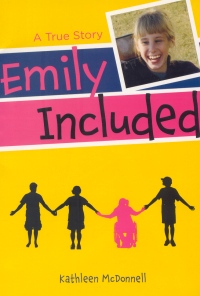| ________________
CM . . .
. Volume XVIII Number 17. . . .January 6, 2012
excerpt:
Emily Eaton fought for her right to be in a regular classroom; she was born with cerebral palsy, but she didn't want to go to a school for children with disabilities. To attend grade one at Maple Avenue School, Emily and her family only needed permission from the principal, but, if she wanted to stay for grade four, she would need approval from the courts. Emily's story begins in 1993 when she's going into school and ends in 2010, long after she's graduated from high school. Although the story isn't narrated by Emily, her emotions and thoughts are communicated by the author ("Toward the end of grade one, Emily began to sense that something was going on—some kind of disagreement between her parents and the school."). Emily showed great determination from a young age. Doctors thought she would never sit up, walk or feed herself. She proved them wrong. At school, she showed an enthusiasm for learning and a willingness to make friends. In court, she endured discomfort from surgery to show her support for the case ("Emily knows that this is an important decision/Not just for her but for all children with disabilities."), and when visiting China for her brother's wedding, she didn't let stairs or non-wheelchair accessible buildings prevent her from touring the Forbidden City. Throughout this book, children will see how the students and teachers included Emily in the class work and what they did to make her feel calm if she became overwhelmed. Black and white photographs and excerpts from Emily's communication book from school are included in many of the short chapters. A message from Emily and the author appear at the end of the story. Recommended. Tanya Boudreau is a librarian at the Cold Lake Public Library in Cold Lake, AB.
To comment
on this title or this review, send mail to cm@umanitoba.ca.
Copyright © the Manitoba Library Association. Reproduction for personal
use is permitted only if this copyright notice is maintained. Any
other reproduction is prohibited without permission.
NEXT REVIEW |
TABLE OF CONTENTS FOR THIS ISSUE
- January 6, 2012.
AUTHORS |
TITLES |
MEDIA REVIEWS |
PROFILES |
BACK ISSUES |
SEARCH |
CMARCHIVE |
HOME |
